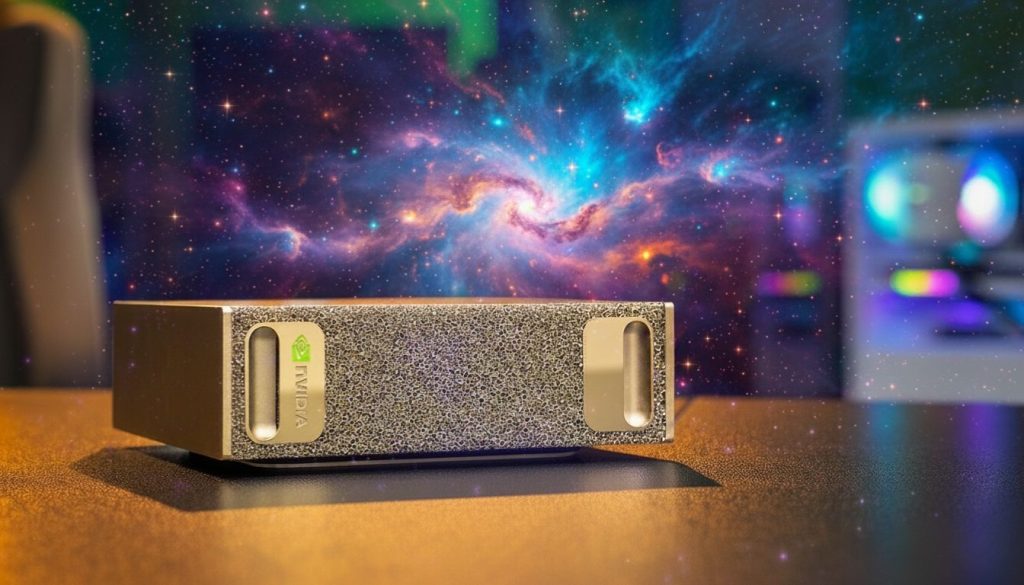
Table of Contents
The Nvidia DGX Spark mini PC represents a turning point in artificial intelligence accessibility. Nvidia just made artificial intelligence development significantly more accessible, and the implications reach far beyond the tech industry’s typical product cycle. The company’s DGX Spark mini PC, launching October 15 for $3,999, represents something more consequential than another hardware release. It’s a deliberate play to reshape who gets to participate in the AI revolution, and whether that access remains concentrated in massive data centers or spreads to researchers, startups, and developers working from home offices and university labs.
This matters because AI infrastructure has become a gatekeeper. Cloud GPU rental costs pile up fast, creating barriers that favor well-funded organizations over independent innovators. A $3,999 desktop can replace hundreds of hours of midrange GPU rental for continuous workloads, with the added advantage that data never leaves your premises and you avoid egress fees entirely.
What Makes the Nvidia DGX Spark Different
The Nvidia DGX Spark packs Nvidia’s GB10 Grace Blackwell superchip along with ConnectX-7 networking capabilities and the company’s full software stack, all compressed into a form factor roughly the size of an Intel NUC. The specifications tell a story about where AI development is heading: 128GB of LPDDR5x memory shared between CPU and GPU, 4TB of NVMe storage, four USB-C ports, Wi-Fi 7, and an HDMI connector. The system runs DGX OS, Nvidia’s customized Ubuntu Linux distribution preloaded with AI development tools.
The 128GB of unified memory proves particularly significant. Developers can prototype, fine-tune, and run inference on the latest reasoning AI models from DeepSeek, Meta, Nvidia, Google, Qwen and others with up to 200 billion parameters locally. That’s not a trivial capability. Most consumer hardware forces developers to quantize large models, degrading performance to fit memory constraints. The Nvidia DGX Spark eliminates that compromise.
Performance specs position this machine between consumer and data center hardware. The Blackwell GPU delivers up to a petaFLOP of sparse FP4 performance, roughly comparable to what you’d find between an RTX 5070 and 5070 Ti, but with vastly more memory. The 20-core Arm CPU handles data preprocessing and orchestration, and the whole system draws just 240 watts, making it remarkably power-efficient for the computational muscle it provides.
The Democratization Question
Nvidia’s marketing heavily emphasizes “democratizing AI,” and there’s genuine substance behind that positioning. As major tech companies continue securing exclusive partnerships with chip manufacturers, access to cutting-edge AI hardware increasingly concentrates among giants with deep pockets and strategic relationships. The DGX Spark creates an alternative path.
Consider the practical economics. Researchers at smaller universities, developers at bootstrapped startups, or independent AI practitioners often face a frustrating calculus: pay cloud providers continuously for access to necessary compute, or abandon projects that require serious hardware. A one-time $3,999 investment fundamentally changes that equation, particularly for teams running extended training sessions or serving models in production.
The system’s clustering capabilities amplify this advantage. The 200 Gbps high-speed networking allows users to connect multiple DGX Spark units, scaling performance without needing data center infrastructure. Nvidia offers a two-unit bundle with QSFP cables specifically for this use case, enabling researchers to build distributed training setups in spare bedrooms or lab spaces.
What This Means for AI Development
The timing matters as much as the hardware itself. We’re entering an era where reasoning models and agentic AI systems demand more memory and sustained compute than previous generations. These aren’t models you run once for inference and forget. They require iterative refinement, continuous evaluation, and the freedom to experiment without watching cloud bills accumulate.
Having local hardware also addresses data sovereignty concerns that government agencies, healthcare organizations, and financial institutions face. Sensitive data never touches cloud infrastructure. Compliance teams breathe easier. IT departments maintain complete control over their computing environment.
But let’s be clear about what the DGX Spark isn’t. This isn’t hardware for training frontier models from scratch. OpenAI, Anthropic, and Google aren’t replacing their data centers with stacks of mini PCs. The DGX Spark targets a different but substantial market: developers fine-tuning existing models, running inference at scale, prototyping novel architectures, and pushing AI research forward without needing institutional backing.
The Broader Market Context

Nvidia’s move follows a familiar pattern in technology democratization. What once required mainframes became possible on workstations. What demanded workstations eventually ran on laptops. Now AI workloads that previously required cloud infrastructure or expensive on-premises servers fit on a desktop. According to research from major tech outlets, this progression often accelerates innovation by expanding who can meaningfully participate.
The competitive landscape makes this launch particularly interesting. Apple’s M-series chips brought unified memory to consumer devices, demonstrating advantages for ML workloads. AMD continues pushing AI accelerator features into their hardware. Intel positions Arc GPUs as viable AI development platforms. Nvidia’s response maintains their lead while acknowledging that AI development tools must become more accessible or risk losing mindshare to competitors who make that accessibility central to their pitch.
Political and Democratic Implications
From a broader democratic perspective, who controls AI infrastructure matters enormously for societal outcomes. Concentrated access to AI development tools risks creating a world where only large corporations and well-funded research institutions can meaningfully contribute to AI advancement. That concentration potentially exacerbates existing inequalities and limits diverse perspectives in AI development.
Making powerful AI hardware available at accessible price points doesn’t solve all equity issues in the field. A $3,999 system still represents a significant barrier for many developers globally. But it does create more on-ramps for participation. Academic researchers at under-resourced institutions gain capabilities previously requiring industry partnerships. Independent developers can prototype ideas that might challenge incumbent approaches. Startups in regions without robust cloud infrastructure can build AI capabilities locally.
The implications extend to regulatory and safety questions. When AI development concentrates in a few organizations, oversight becomes easier but also more politically fraught. Distributed development creates complexity for regulation but also resilience against single points of control. The DGX Spark nudges the ecosystem toward the latter model.
Looking Forward
Nvidia will begin selling the DGX Spark through Nvidia.com and select third-party retailers starting October 15. The company also has a larger DGX Station in development, suggesting this product line represents an ongoing strategy rather than a one-off experiment.
The real test comes in adoption patterns over the next year. Do research labs actually deploy these systems? Do startups build products around them? Does a developer community emerge sharing techniques, benchmarks, and use cases? Hardware availability only matters if it enables work that couldn’t happen before.
Early indicators suggest genuine demand exists. Preorders opened in March, giving Nvidia months to gauge market interest before official launch. The company’s decision to proceed with full availability implies those signals proved positive.
The $3,999 DGX Spark won’t replace cloud computing or eliminate the need for massive data centers training frontier models. But it does create meaningful new possibilities for who can work on AI and how. In an industry frequently criticized for concentrating power and access, that shift deserves attention. Whether it truly democratizes AI development or simply adds another tier to existing hierarchies will depend on what developers actually build with these systems and whether Nvidia continues pushing accessibility beyond this initial product.
For now, AI development just became available to a significantly wider audience. What they do with that access matters more than the hardware that enables it.